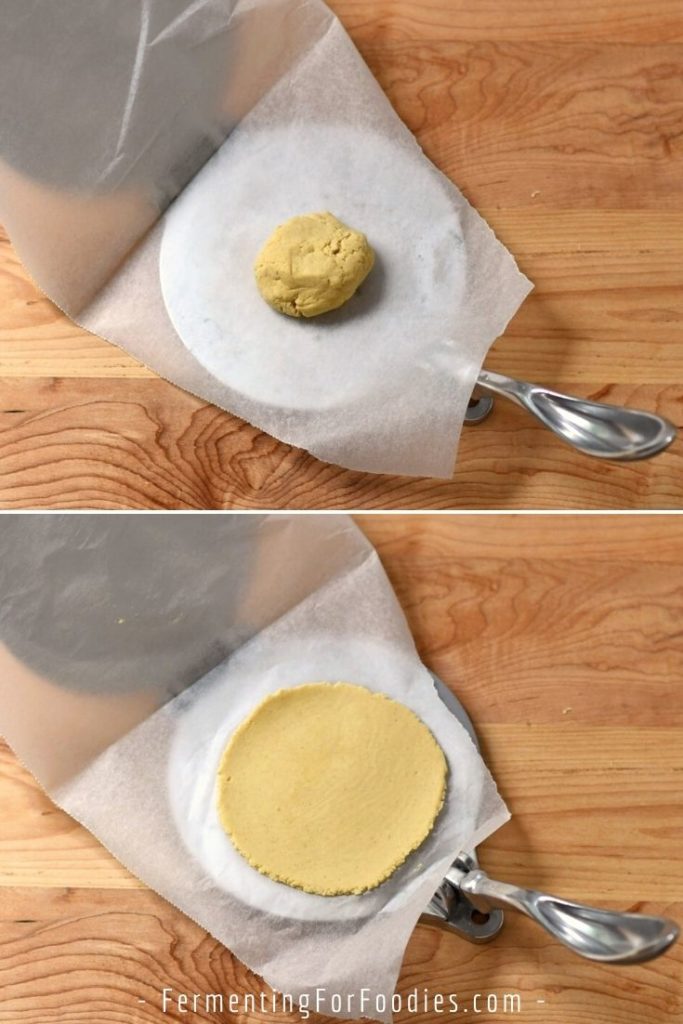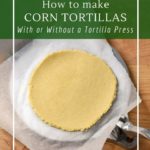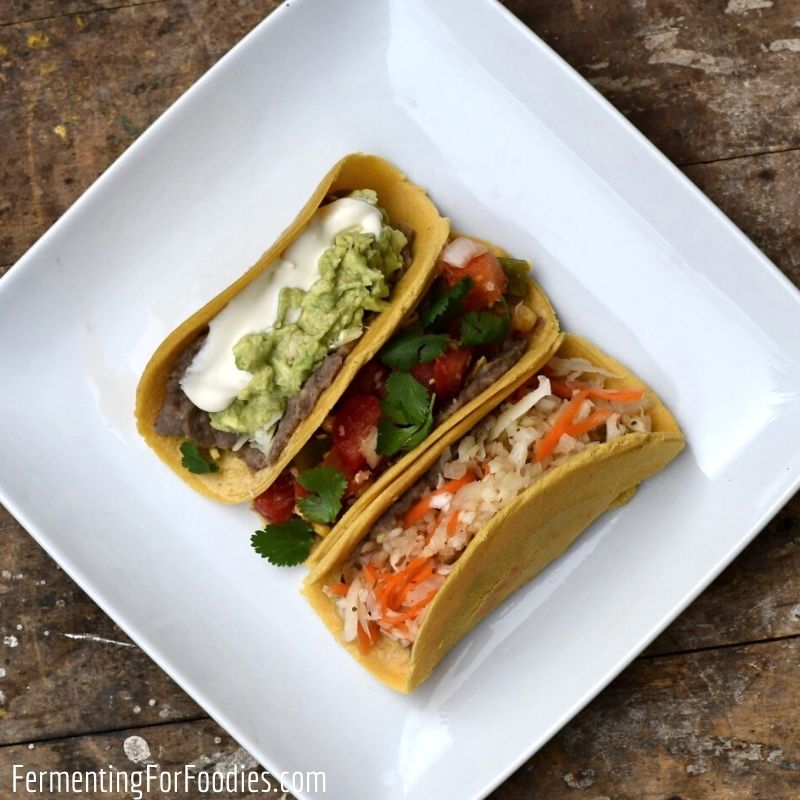Nixtamalization and Fermentation
Traditional corn tortillas use masa flour, which is corn that has been fully nixtamalized. This is a process that involves soaking and cooking dried corn in an alkaline solution to break it down. It improves the nutritional content of corn and is necessary for soft tortillas. However, it is not technically a form of fermentation.
Despite the alkaline nature of masa flour, it is still readily fermentable by Lacto-bacteria. Fermented corn tortillas have a tang of sourness that nicely compliments a spicy Mexican meal. Fermenting also ensures a nice smooth dough that is easy to work with.
Regardless, masa flour needs to soak to fully hydrate before making tortillas, so you might as well add a bit of culture and make fermented corn tortillas!
How to form tortillas
Probably the easiest way to make tortillas is with a tortilla press. While I recently bought one at a garage sale, for years I formed tortillas by hand, using one of these methods.
- Homemade press: Use a heavy, flat-bottomed pot as a tortilla press. My cast-iron dutch oven is perfect. Just flatten a ball of dough, then use a heavy pot to press it flat.
- Roll by hand: Most of the time I rolled out each tortilla individually on a pastry mat. The pastry mat made it easy to peel off the soft tortilla.
- Tortilla Press: It took me about a year to figure out the best way to use my tortilla press. (Despite watching several demonstration videos!) There are two secrets: first, use wax paper or parchment paper to prevent sticking. Second, place the ball of dough slightly closer to the hinge (not in the center) so it presses across the surface.
- Usually, I’m not fussy, and I leave the tortillas with uneven edges. However, when I’m serving tortillas to guests (or photographing my tortillas), I use a 6″ diameter pot lid to cut out a perfect circle after rolling.

Homemade Corn Tortillas
Homemade tortillas are easy and way more delicious than store-bought ones. Here’s how to make them without a tortilla press or special tools. Fermenting isn’t necessary, however, it’s an easy way to make sure you have a nice and soft dough.
- Prep Time: 5 minutes
- Cook Time: 10 minutes
- Total Time: 15 minutes
- Yield: 12 to 16 1x
- Category: Bread
- Method: Fermented
- Cuisine: Mexican
- Diet: Gluten Free
Instructions
- Mix the flour, salt, and water in a glass bowl. If fermenting, replace 2 Tbsp of the water with 2 Tbsp of culture (see notes for details).
- Leave the dough to hydrate at room temperature for a minimum of 30 minutes and up to 8 hours.
- Divide the dough into 12 to 16 equal pieces, and form into tortillas. I usually make 12 medium-sized tortillas. See the section above for different methods of forming a tortilla.
- Heat a griddle to medium heat. Working quickly, toast the tortilla for a minute on each side. Wrap freshly cooked tortillas in a tea towel to keep warm and serve immediately.
Notes
- To ferment the masa flour, add 2 Tbsp of yogurt, sauerkraut juice, kombucha, or milk kefir.
- Corn ferments really quickly so don’t leave it out for more than 8 hours. Even 2 hours should be enough, as the masa will quickly become sour.
- I use a hot cast iron skillet
to cook my tortillas, but a non-stick pan
would work as well. Either way, don’t use oil because these are toasted not fried.
- The corn tortillas can be frozen after toasting. Just stack them in a zip-top bag and save them for future use. Reheat from frozen by toasting for 2 minutes on each side.
- We love curtido and fermented salsa for delicious and probiotic additions to our tacos.
- Don’t use corn flour. It’s not the same thing and the results won’t be the same.






A trick for you: Roll the tortillas into a ball and then put it between two pieces of plastic (like a gallon ziploc bag split in half) and then use a plate to press it down. Makes even thinness and perfect round shape! Love the idea of fermenting them a bit. Thanks 🙂
What a great idea! I will definitely try that the next time. Thanks!
Could you use sourdough starter as your fermenting culture?
Yes! Just start with a really active starter, and maybe give it a bit longer to ferment.
Cool! I plan on giving it a shot this weekend! Thanks for the response.
I saw the comment about sourdough! Good to know!
How about cultured buttermilk?
Yes! I usually use milk kefir or yogurt, so buttermilk should be fine. Enjoy!
Worked out great. I had to knead the dough a bit more than I thought to when I started out in order to incorporate it all together; so accustomed to wheat dough with its different moisture levels.
Glad it worked out. It is different from bread dough. Quite firm and dry in comparison.
Hi Emilie,
Can you go into detail about types of cornmeal that would be suitable for fermentation? Is Maseca Cornmeal okay to use? Thanks!
I have only used masa flour, not cornmeal, as cornmeal is too coarse to make tortillas. I believe that Maseca is a particular brand of masa flour, so it should be fine!
Hey, just a question.
Can I ferment the flour with just salt and water?
Thanks!
You could ferment with just flour and water, like sourdough. Then add the salt afterwards. However, it will take around 3 to 5 days to ferment masa flour that way. Enjoy!
Many thanks for this recipe – and all the others!
Have been wondering if co use Masa Harina this way since is it one of my dietary staples.. recently got back to making Kefir and this sounds pretty tasty. Right now I have some Organic BLUE Corn Masa Harina on hand so will start with that. AND, will begin working my way thru all your other recipes too.
Wow! I’ve never seen blue corn masa flour… that sounds delish!
Hello, I am interested in fermenting food. However, far more water needs to be used in this recipe. This is because masa dough needs to be repeatedly kneaded until there are no hard spots left, but it shouldn’t stick either. I would estimate a total of 1 3/4 to 2 cups water.
Water must be added gradually, starting from 1 cup and then added in increments. The total time for kneading is about 30 minutes.
Hi Yuval, I had to delete the video link as my anti-spam software wouldn’t let your comment be posted. Honestly, I make tortillas following this recipe about once a month. We’ve never had an issue. Because the dough is mixed in advance, then fermented, I think the hydration ratio is different. Cheers, Emillie